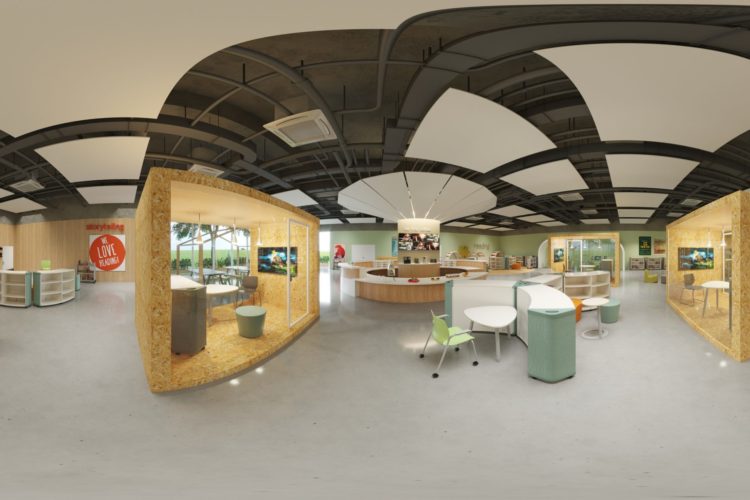
Learning Commons: How Technology is Changing 21st-Century Library Design

The rise of digital technology and innovative new approaches to education have given rise to a new sort of library: the learning commons.
To adapt to the changes brought on by the rise of digital technology and 21st-century learning principles, an evolution in library design and space planning, ranging from furnishings and architecture to culture and purpose, has also gradually occurred. Schools around the United States and the world are beginning to transform their libraries from being silent temples to hold collections of books and reference materials into multi-use learning commons spaces, which are intended to be hubs of creativity and marketplaces of ideas. Along with technological change, this relatively new trend comes as a reaction to rapid changes user needs.
Many schools have already transitioned their outdated libraries into learning commons, which can be defined as a full-service learning, research, and student-centric collaborative project space. In a learning commons, students can work independently or in groups in planned learning zones that isolate activities, such as individual study or social learning where students are encouraged to interact with each other.
From Isolation to Collaboration
With the exception of the student who needed a quiet or alternative location to study, late 20th century libraries were still primarily used by students as resource centers to get what only what was needed for a project and leave. Only recently has the philosophy of today taken over--that libraries should offer both quiet and collaborative learning opportunities along with access to cutting-edge technology and, in some cases, even food. According to Loyola Dean of Libraries Robert A. Seal, “Books, articles and conference papers in most of the 20th century reflected a philosophy that library space should be designed by and for librarians. User needs, while recognized, often came second.” In the case of a learning commons, the user needs come first and, in an ideal space, the design and furnishings reflect that attitude.
As a 20th century student, going to the library typically meant silently studying books and other printed materials on your own, but over time, librarians began to see usage decrease as students opted instead for studying in spaces such as coffee shops or bookstores that offered comfortable chairs, refreshments and more opportunities to collaborate. Only the libraries designed to imitated these spaces geared towards 21st-century learners saw attendance and usage rise.

Designing a Learning Commons or 21st Century Learning Environment?
Furnishing the Future
When it comes to the process of planning and designing a learning commons, there are a lot of moving parts, but arguably one of the most important elements of the design process is how you decide to furnish it. After all, modern students have modern needs. A 21st-century student might be conducting research, studying, surfing the web, and talking to classmates--all at the same time. This would be very difficult to accomplish, if not impossible if the student was isolated in a study cube in a silent 20th-century style library. He or she would be more successful in a more dynamic learning commons environment, which could be adapted to suit their needs. Simply put, successful 21st-century learning necessitates 21st century furniture. Furniture now plays an active role in the learning process. It can make or break the student’s ability to adapt to different learning situations or effectively collaborate with his or her peers.

In 2012, Groveland Elementary in Minnetonka, MN transformed their outdated library into a modern learning commons to help students collaborate and easily share their work with one another. Key to the success of Groveland’s library redesign was updating the furnishings. The goal was to create a student-centric learning environment with the optimal space needed for collaborative work. In fact, Groveland cared so much about making the space student-centric that they went as far as collecting feedback from 5th graders, who suggested a “reading by the lake” theme, which was incorporated into the final design.
The school carefully designed the new learning commons with multi-use furniture, modifiable learning spaces and mobile computing in mind. For example, confining shelving to the perimeter of the commons allows for central areas to be filled with adaptable furniture easily configurable to meet a wide range of student and faculty needs. In the large group area, there is flexible lounge seating to encourage creativity and critical thinking skills. Similarly, to help students stay engaged and be productive, all of the furniture is ergonomically designed to support active learning.
According to Groveland’s principal David Parker, transitioning from an old fashioned library to a new learning commons revitalized their space and invigorated students and faculty:
Learning Commons Challenges
While there are many educational benefits to transforming a traditional library into a learning commons, there are also a few challenges:
Looking Forward
To remain useful, a learning commons must be able to adapt to the evolving needs of students and technology. For example, mobile use, 3D display, and gesture-based computing are on the rise. Consequently, this means that commons spaces will eventually need to integrate even more cutting-edge technology into their processes. It will certainly be a challenge for learning commons to keep up with the pace of technological advancement, however, it is also an opportunity for schools to get students even more engaged and facilitate even greater collaboration.
It’s also important to remember that, although commons are student-centric spaces, they benefit the entire community. It gives faculty members much more flexibility when scheduling activities because everything is centralized to one adaptable space that can accommodate a wide variety of student needs. Lastly, and arguably most importantly, learning commons benefit students by allowing them to forge their own approach to their work and by giving them the tools and resources they need--computers, room to collaborate, research resources and anything else they need to complete a project successfully and genuinely learn something in the process.
Ready to get started? Request a quote by clicking the button below:
Works Cited
- "7 Things You Should Know About the Modern Learning Commons." 7 Things You Should Know About the Modern Learning Commons. Educause, 11 Apr. 2011. Web. 11 Nov. 2015.
- "Active Learning Classrooms." Active Learning Classrooms. University of Minnesota. Web. 11 Nov. 2015.
- "Groveland Elementary School, Learning Commons." Groveland Elementary School, Learning Commons. Web. 11 Nov. 2015.
- "Learning Commons." Learning Commons. Groveland Elementary School. Web. 11 Nov. 2015.
- "Library Redefined." Library Redefined - Research Herman Miller. Web. 11 Nov. 2015.
- Seal, Robert. "Library Spaces in the 21st Century--Meeting the Challenges of User Needs for Information, Technology, and Expertise." Loyola ECommons. 1 July 2014. Web. 11 Nov. 2015.
Categories
Recent Posts
 Employee Spotlight – Meet Manuel Paredes
Employee Spotlight – Meet Manuel Paredes How to Create a Dynamic Active Learning Environment with School Furniture
How to Create a Dynamic Active Learning Environment with School Furniture The Power of Choice–Platinum & Clear Totes Now Available
The Power of Choice–Platinum & Clear Totes Now Available Leaping into Latin America: Smith System Expands Furniture Footprint
Leaping into Latin America: Smith System Expands Furniture Footprint Furniture Overhaul Turns Special Ed Science Classroom into ‘Science Oasis’
Furniture Overhaul Turns Special Ed Science Classroom into ‘Science Oasis’ Leveraging Technology to Support Student Wellbeing
Leveraging Technology to Support Student Wellbeing Designing Flexible Learning Spaces for Ed Tech Integration
Designing Flexible Learning Spaces for Ed Tech Integration How Technology is Shaping the Future of Learning
How Technology is Shaping the Future of Learning
Recent Posts
- Employee Spotlight – Meet Manuel Paredes
- How to Create a Dynamic Active Learning Environment with School Furniture
- The Power of Choice–Platinum & Clear Totes Now Available
- Leaping into Latin America: Smith System Expands Furniture Footprint
- Furniture Overhaul Turns Special Ed Science Classroom into ‘Science Oasis’


